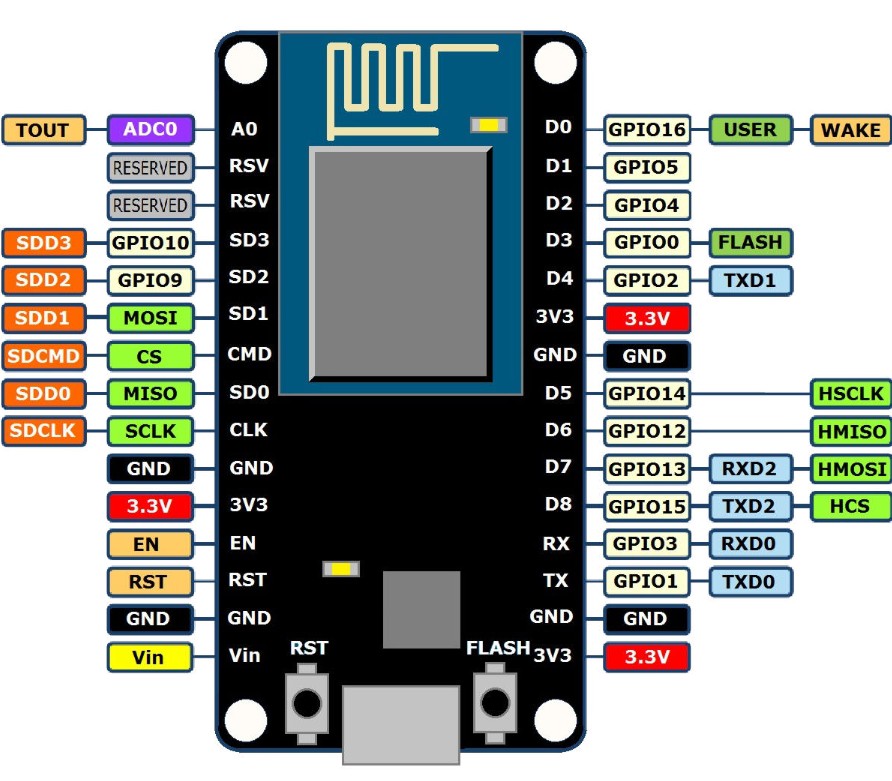NodeMCU ESP8266 V3 Lua CH340 WiFi Development Board - Complete Guide

The NodeMCU ESP8266 V3 Lua CH340 WiFi Development Board is a powerful, low-cost IoT board that revolutionized the maker community with its built-in Wi-Fi capabilities. This compact board combines the ESP-12E module with USB-to-serial CH340G chip, making it perfect for IoT, home automation, and WiFi-controlled projects.
In this comprehensive guide, we'll explore the specifications, programming options, and how ESP8266 compares with its successor ESP32 to help you choose the right board for your project.
Did You Know?
The ESP8266 was initially developed as a low-cost WiFi module by Espressif Systems, but the open-source community quickly adopted it, creating the NodeMCU development board that made IoT accessible to millions of makers worldwide.
Key Specifications of NodeMCU ESP8266 V3
| Feature | NodeMCU ESP8266 V3 | ESP32 DevKit v1 |
|---|---|---|
| Processor | Single-core Tensilica L106 @ 80-160 MHz | Dual-core Tensilica LX6 @ 240 MHz |
| WiFi | 802.11 b/g/n (2.4 GHz) | 802.11 b/g/n (2.4 GHz) |
| Bluetooth | Not Available | Bluetooth 4.2 (Classic + BLE) New |
| Flash Memory | 4 MB | 416 MB |
| SRAM | 128 KB | 520 KB |
| GPIO Pins | 11 Digital I/O, 1 Analog Input | 34 GPIO with multiple functions |
| USB-Serial | CH340G Reliable | CP2102 or CH340 |
| Operating Voltage | 3.3V | 3.3V |
| Price Range | ₹150 - ₹250 Budget | ₹400 - ₹600 |
Why Choose NodeMCU ESP8266 V3?
The NodeMCU ESP8266 V3 remains an excellent choice for many projects due to its:
- Extremely Affordable Price - Perfect for budget-conscious projects
- Proven Reliability - Mature ecosystem with extensive community support
- Low Power Consumption - Ideal for battery-powered IoT devices
- Easy Programming - Compatible with Arduino IDE, Lua, and MicroPython
- Compact Size - Fits in small projects and prototypes
- CH340G USB Chip - Stable serial communication with computers
Programming the NodeMCU ESP8266 V3
You can program the ESP8266 using multiple development environments:
1. Arduino IDE (Most Popular)
Add ESP8266 board support to Arduino IDE and program using familiar Arduino syntax with WiFi libraries.
2. Lua Scripting (Original NodeMCU)
Use the Lua programming language for rapid development of IoT applications.
3. MicroPython
For Python enthusiasts, flash MicroPython firmware and code in Python.
Driver Installation Tip
The NodeMCU ESP8266 V3 uses CH340G USB-to-serial chip. You may need to install CH340 drivers on your computer. These are easily available for Windows, Mac, and Linux systems.
Popular ESP8266 Project Ideas
The NodeMCU ESP8266 is perfect for various WiFi-enabled projects:
- Smart Home Automation - Control lights, fans, and appliances
- Weather Station - IoT weather monitoring with web interface
- WiFi Robot - Remote controlled robot over WiFi
- IoT Data Logger - Sensor data logging to cloud platforms
- Web Server - Host simple web pages and APIs
- MQTT Client - IoT messaging for home automation
ESP8266 vs ESP32: Which Should You Choose?
Choose ESP8266 When:
- Your project only needs WiFi (no Bluetooth)
- You're working with a tight budget
- Basic IoT applications with moderate processing needs
- Simple sensor monitoring and control
- Learning IoT programming for the first time
Choose ESP32 When:
- You need both WiFi and Bluetooth
- Dual-core processing power is required
- Advanced projects with multiple sensors
- Bluetooth Classic or BLE applications
- More GPIO pins and advanced peripherals needed
Where to Buy NodeMCU ESP8266 V3 Development Board
Ready to start your IoT project with the reliable NodeMCU ESP8266 V3? Get authentic boards with warranty from RobuKits:
Buy NodeMCU ESP8266 V3 from RobuKitsFree shipping available across India | 7-day replacement policy
